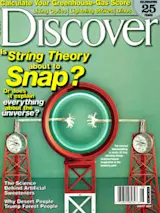Planetary scientists have long suspected there was something strange about Saturn’s 140-mile-wide satellite Phoebe. For starters, it is tipped on one side, and it revolves in the opposite direction from the planet’s other 46 moons. Last year detailed Cassini images showed Phoebe as dark and highly pockmarked, with bright streaks beneath the craters. That gave scientists the idea that the moon was a former comet. Now they have proof.
Using Cassini’s visible and infrared mapping spectrometer, planetary scientists discovered that Phoebe’s surface is among the most complex in the solar system. The mishmash of water ice, iron-rich minerals, organic and cyanide compounds, and possibly clays could have been created only if Phoebe had once done loops through the solar system. Researchers suspect that Phoebe’s surface has probably changed very little during its captivity, meaning the moon offers unprecedented insights into objects in the Kuiper belt, the icy band from which comets arise.
Meanwhile, time-lapse Cassini images reveal yet another moon nestled within a gap in Saturn’s outermost A ring. The little five-mile-wide moon, named S/2005 S1, is only the second to be discovered within the rings. As it orbits, its gravity kicks away ring particles, clearing a wavy path through the gap. Most likely, it won’t keep moving for long. Between abrasion from micrometeors and ring dust, it will eventually erode away and become part of the ring itself.














